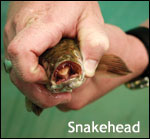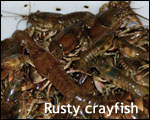|
Pathways for Invasions . . . . . . . . . .
|
A grab bag of non-native species — from repulsive rock snot to attractive water lettuce — lives in the Chesapeake and its tributaries. Credits: Zebra mussels, NOAA; Snakehead, U.S. Geological Survey; Bait, Matthew Sell; Fishing geer, Stephen Witherden; Didymo, Maryland Department 0f Natural Resources; Water lettuce, Nancy Rybicki; and Nutria, Carol A. Holko. |
BALLAST WATER isn't the only way that non-native species move from place to place. How we work and play and even some of our cultural traditions can all contribute to the spread of potentially invasive animals, plants, and microbes. The study of these pathways — a field called vector ecology — has emerged as a key part of efforts to avoid species invasions. Here's a look at some of the top vectors on the minds of scientists and managers.
Hull Fouling
While organisms transported inside ballast tanks seem to garner the most attention, those attached to the outside of a ship may be equally — or more — to blame. "It's not just about ballast," says invasive species expert Greg Ruiz of the Smithsonian Environmental Research Center (SERC). "There's pretty good evidence, both within the Chesapeake and on a national scale, that hull fouling is really important as well."
Attached to the hulls of commercial ships, fouling organisms like mussels, barnacles, and encrusting algae can spread around the globe. Researchers at the SERC Marine Invasions Research Laboratory study ways to stem fouling through the use of special paints and other physical means. In the coming year the SERC scientists plan to work with the Maritime Environmental Resource Center as it also dives into the hull fouling arena. An added incentive to fix the problem? Biofoul-ing increases drag, which increases travel time and fuel consumption.

But commercial ships are not the only culprits for spreading fouling organisms. While ballast water likely brought the zebra mussel to North America, recreational boats have largely contributed to the bivalve's spread — so-called secondary invasions — throughout lakes and rivers of the midwest, south, and northeast. In the fall of 2008, six zebra mussels showed up near the lower Susquehanna River — one on a boat hauled out for the winter. This year, the Maryland Department of Natural Resources (DNR), with additional support from Maryland Sea Grant, sent all boat registration holders a flyer urging them to take extra steps to clean their boat, trailer, or dive gear.
Live Trade
Global commerce has made it easier than ever to exchange goods — and non-native species. Greg Ruiz thinks the trade of live plants and animals is playing an increasing role in aquatic invasions. But this market is constantly in flux, he says, and scientists don't know enough about it.
Seafood

The discovery of snakeheads, predatory Asian fish, in a Crofton, Maryland pond in 2002 captured significant attention and led to a successful effort to eradicate them in the pond. A local resident ultimately admitted to having released two snakeheads into the pond after purchasing them at a live seafood market in New York. Another introduction in a Virginia creek has led to snakeheads thriving throughout the Potomac River and tributaries in Virginia and Maryland.
Aquarium Pets
Exotic aquarium pets can also wind up in a new environment. Jonathan McKnight, co-chair of Maryland DNR's Invasive Species Matrix Team, notes that pacu fish, a South American species that closely resembles a piranha and is popular with aquarists, have periodically shown up in Maryland waters. Ruiz says such introductions to the wild usually occur when people no longer want to take care of their pets. Working with the Maryland Association of Pet Industries, DNR and Maryland Sea Grant have produced a poster for use in pet stores advising pet owners not to release non-native animals into the environment.
Bait

Unused bait discarded into a waterway at the end of a day's fishing also leads to invasions. McKnight notes that non-native species are widely available in bait shops throughout the area. This is probably how rusty crayfish, native to parts of the midwest, ended up in Maryland. Blamed for displacing native crayfish and preying on plants and invertebrates, "rusties" are now illegal to use as bait.
Fishing Gear
Along with boats, fishing equipment can also serve as a vector for invasion. Wading gear can carry microscopic organisms from one stream to the next. McKnight notes that the tendency of fly fishermen to travel — Montana one weekend, Maryland the next — complicates the problem.
In 2008, the discovery of an invasive algae referred to as Didymo (short for Didymosphenia geminata) spurred sharper vigilance in Maryland. Also called "rock snot," the algae can form slime-like mats that cover stream bottoms, smothering life. To combat the spread of Didymo and other invasive organisms like it, Maryland DNR asks fishermen to use rubber-soled waders — rather than felt, which can hold more water and more organisms — and to disinfect gear with detergent or salt solution.
Water Gardens

Invasive plants used in aquatic gardens pose a threat as well. Pond owners who dispose of plants improperly or ponds that overflow in heavy rains can introduce non-native species into local streams and rivers. In 2007, officials found water lettuce, an attractive but troublesome weed, in Mattawoman Creek, a tributary of the Potomac River. Biologists say non-natives like this can crowd out native plants, block sunlight, deplete oxygen, and even impede boating. Since water lettuce is tropical, its presence here provokes another question. Will rising temperatures allow warm-weather species like this to survive and spread farther north?
Intentional Introductions
Honeybees, cattle, carp. Non-native species don't always appear by accident. Often they're introduced as part of a larger plan — to boost agriculture, the fishing industry, recreational activities, the list goes on. But even species meant to enhance our quality of life have the potential to cause unintended negative consequences.

In the 1950s, semi-aquatic rodents called nutria were introduced to Maryland in an effort to promote the fur industry. The highly prolific animal eventually overran Chesapeake Bay marshes, destroying vegetation and outcompeting native muskrat. Decades later, a multi-agency partnership to control the nutria population through trapping and hunting has successfully cleared over 150,000 acres of nutria. But work remains as managers continue to inspect hundreds of thousands of additional acres.
More recently, a proposal to introduce an Asian oyster, Crassostrea ariakensis, in the Chesapeake showed how heated the issue of intentional non-native species introductions can get. While some argued that the introduction could help restore oysters to the Bay, others cried foul. They argued that the non-native oyster could bring disease and unforeseen problems to the Bay. In March 2009, after years of studying the issue, state and federal officials announced that they had abandoned the idea of bringing in the non-native oyster — at least for now.
Jessica Smits
|

